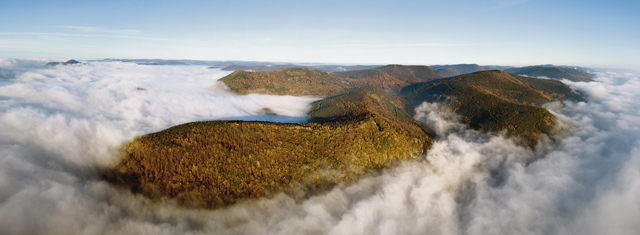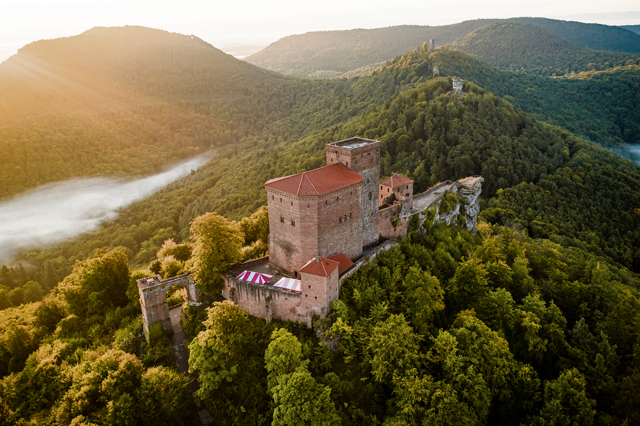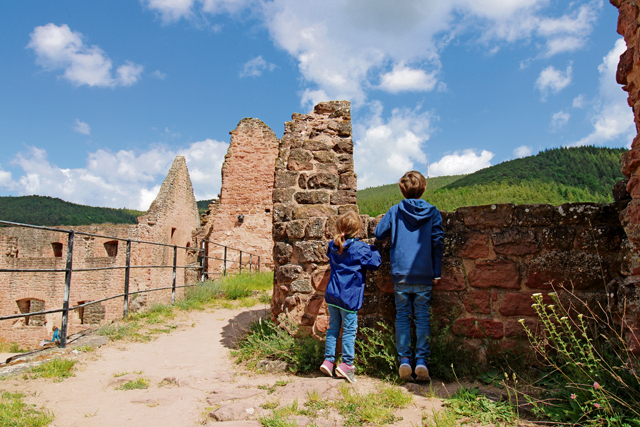The Nature Park of the Palatine Forest was created to protect the landscape for the leisure of the people in the surrounding cities, said Arno Weiss, the deputy director of the Naturpark Pfaelzerwald. The entire area is protected to maintain its diversity, uniqueness and beauty — and it’s still an excellent site for relaxation.
History and mystery
Wild tales abound to explain some of the strange landscapes found in the area.
One of those tales is the story of the Devil’s Stone in Bad Duerkheim: In the Middle Ages, the devil was walking through the forest when he saw a group of monks working. He asked the monks what they were building and the monks, seeing that it was the devil, lied to him. They told the devil that they were building a gasthaus. The devil thought that he could capture many souls in a gasthaus, with all the drinking and gambling — so he helped the monks.
But the monks had built a cloister. The devil was angry and grabbed a huge stone to crush the cloister. At that time, the first bell rang out and surprised the devil, making him drop the giant rock. Now, when you walk through the forest you can see this huge stone alone in the middle of the forest.

Find the romance and shoes?
The Palatine Forest borders the vineyards of the German Wine Route. Along this route, you find towns and villages with their own romantic charm, appeal and wine culture. The region around Kaiserslautern-Süd, Lambrecht, Elmstein, Tripstadt, Rodalben and Waldfischbach-Burgalben is considered the center of the Palatine Forest. Take a visit to the city of Neustadt an der Weinstrasse and stroll through the old part of town and around the Stiftkirche. The market place is the center of the city and is surrounded by historic buildings, including the city hall.
The Verbandsgemeinde Lam-brecht should be called the “vital valley” because it is known for its recreational opportunities like climbing, hiking or bicycling. Just as in bygone days, you can ride a steam train through the Elmsteiner Valley and visit at least half a dozen old castles.
Burg Spangenberg’s annual Knight Games/Medieval Festival in May is a famous event worth checking out. There are also many forest cottages that offer hikers and bicyclists good and hearty Palatine cooking.
The region of Hauenstein is known for the Teufelstisch and for shoes. The Teufelstisch, or Devil’s Table, is one of the most bizarre rocks in the southwest Pfalz. Shaped by the weather, the rock looks like a colossal sandstone tabletop. Right underneath the Teufelstisch, children can let off steam in a large adventure playground.

The shoe industry has greatly impacted Hauenstein over the past 100 years. Visit the German Shoe Museum, which brings to life the amazing times that affected the region (www.deutsches-schuhmuseum.de). Here you will find the original machinery once used to produce old shoes along with a historic timeline covering the past two centuries.
You can also see a unique and oddly entertaining exhibit: used shoes from German celebrities such as Boris Becker, Steffi Graf, Helmut Kohl or Luis Trenker. Of course, you can buy shoes in this region at every corner. After you buy some shoes, try them out on one of the region’s many hiking trails.
Hiking the forest
If you like to hike, the Pfalz is the place to be. There are 92 parking areas for hiking paths that cover more than 2,200 kilometers of beautiful territory. Even if you’re unfamiliar with the region, you can venture out with confidence: The signs are easy to understand and visible.
You won’t need to take the contents of your fridge along for the hike because 45 cottages offer food and snacks along the way, as do 14 Friends of Nature cottages and 50 restaurants.
You can find maps for your next hiking trip in this region at pfaezerwald.de or in your local bookstore.Wild and Hiking Park Silz: More than 400 animals and 15 species call Wild Park Silz home. These animals are primarily native to the region and climate. The adventure playground and the petting zoo are two fun options for children. Visit www.wildpark-silz.de.
Royal ruins
There are more than 100 castle ruins on the land of the Pfaelzerwald. It was the center of the Holy Roman Empire in the Middle Ages.

Kaiserburg Trifels (Emperors’ Castle): The Kaiserburg was the favorite castle of Emperor Barbarossa; you can see it from a distance as it towers over the town of Annweiler. The castle was once a notorious state prison with an equally infamous prisoner: the English King Richard Lionheart. For details, visit, www.trifelsland.de.
Burg Berwartstein: You’ll be hard-pressed to find an experience of the Middle Ages that’s as gripping as Burg Berwartstein. The tour of this castle, which uses candles at times, will lead you through torture chambers and secret passages. To get to the castle, you enter a vertical cave, which once made this castle almost impossible to conquer. Pay attention to the incredible architecture and sample some original hearty kitchen fare; visit the dark arms room to examine mighty weapons once used to defend this structure. For details, visit, www.burg-berwartstein.de.
Ore Mine St. Anna-Stollen: At St. Anna-Stollen, you can learn all about ore mining by hand. Technical machinery, shafts and colorful ore ledges show how a mine operated. For details, visit www.northweiler.de/erzgrube.
Leisure in the Southwest Pfalz: The Südwestpfalz sits on the border of the French Alsace region and belongs to one of the most interesting and romantic regions of the Pfalz. The Palatine Forest is part of this vacation region. The other part is the fertile Sickinger Hoehe, which is a very old, traditional region dedicated to agriculture, as seen by the many billowing cornfields and windmills.
The Leininger Land: The Leiniger Land is in the north of the county of Bad Duerkheim on the German Wine Road; forest, wine and castles are the best three nouns to describe this region. Here you will find beautiful hiking trails and former quarries that offer a unique recreational area with rare plants and animals. The cities of Wattenheim and Altleinigen feature an impressive castle. Gruenstadt is the center of the Leinigenland, which is the crossroads between the German Weinstrasse (B271) and the A6 Mannheim – Saarbrücken.
For more information on the Nature Park Palatine Forest, visit www.pfaelzerwald.de.


